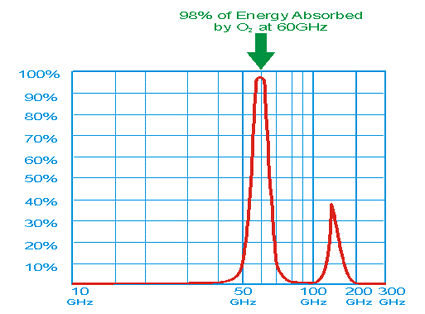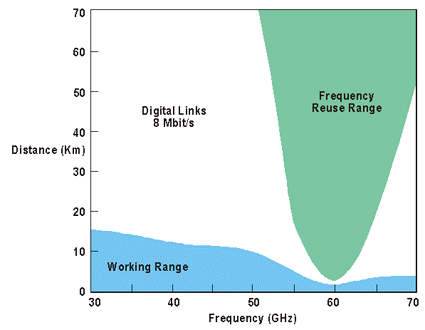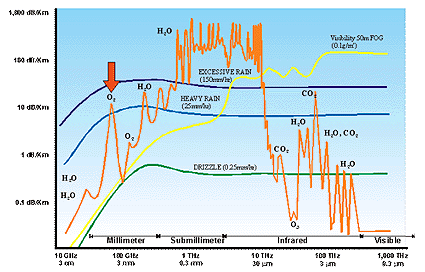April 10, 2001
The demand for bandwidth is growing at a rapid pace. International Data Corporation projects that Internet commerce in the United States will grow from $74 billion in 1999 to $708 billion in 2003, with the number of computer users more than doubling from 81 million to 177 million in the U.S. alone. Due to the tremendous expected growth, reliable fiber optic networks must be installed quickly.In the United States, less than five percent of all commercial office buildings have access to fiber cables. With the high costs to install physical fiber, up to $250,000 per mile, many stopgap techniques, including ISDN, DSL, satellite and microwave communications links, have been deployed to overcome this “last mile” challenge. However, these techniques pose only temporary solutions, as ISDN and DSL require bandwidth from physical mediums that were not designed for Internet use, and available licensed microwave frequencies, 900MHz to 40GHz, and satellite frequencies, 6GHz to 30GHz, are limited.Short haul, high-density deployments of wireless communications devices are required in metropolitan areas and business parks throughout the United States. Most often, office buildings though not physically linked to the fiber backbone are within one half mile of a local fiber trunk. Wireless communication devices operating at higher frequencies, such as 60GHz, allow businesses to link to the fiber easily, without the cost and time delays associated with physical fiber installation.
Due to the increased bandwidth demands and the scarcity of microwave frequency allocations, the wireless communications industry is beginning to focus on higher, previously unallocated portions of the spectrum in the millimeter wave frequencies from 40GHz to 300GHz. Due to the high levels of atmospheric RF energy absorption, the millimeter wave region of the RF spectrum is not usable in long haul, wireless communications segments. However, for short haul, “last mile” segments, the expanded RF data bandwidth available in the millimeter wave region makes it ideal for interference free, fiber speed connectivity.
Figure 1 illustrates the atmospheric absorption for millimeter wave frequencies.
At the millimeter wave frequency of 60GHz, the absorption is very high, with 98 percent of the transmitted energy absorbed by atmospheric oxygen. While oxygen absorption at 60GHz severely limits range, it also eliminates interference between same frequency terminals.


Traditional wireless communications systems operating in the lower frequency ranges of 900MHz to 40GHz often interfere with each other when placed too closely together. This interference, due to the dispersion and uncontrolled propagation of RF energy through the atmosphere is minimized by FCC frequency coordination, licensing and through the implementation of interference avoidance techniques such as spread-spectrum modulation. FCC Licensing precludes dense deployment through the limited number of regional licenses granted and spread-spectrum techniques have proven only marginally effective, as the overall noise floor has risen. In the 60GHz region, the effects of oxygen absorption and the use of narrow beam antennae minimize the probability of interference between the radios. Theoretically, 100,000 systems operating at 60 GHz can be co-located in a ten square kilometer area without interference problems.
Weather conditions have an adverse effect on all RF transmissions, especially in the millimeter wave region where severe rainstorms can cause as much as a 20dB loss in signal strength for every kilometer of transmission. As the distance the radio transmission increases, the fade margin needed to compensate for weather effects increases proportionately. Since radios operating at 60GHz transmit only over short distances, the compensation for weather effects is not as great as for systems transmitting one kilometer and beyond.
At 60GHz, the extremely high atmospheric absorption level is due primarily to the molecular composition of the atmosphere. Figure 3 illustrates the atmospheric attenuation characteristics for wavelengths from 3 cm to 0.3 mm. For millimeter waves, the primary absorption molecules are H2O, O2, CO2 and O3. Since the presence of O2 is fairly consistent at ground level, its effect on 60GHz radio propagation is easily modeled for margin budgeting purposes. In addition, the high level of attenuation from oxygen absorption makes even the worst weather-related attenuation insignificant, especially on the short paths where 60GHz systems operate. Even extremely heavy rainfall, 25mm/hr (5dB/KM), will make only a very small percentage contribution to aggregate attenuation in the 60GHz oxygen absorption region.

Due to the unique characteristics of the 60GHz millimeter wave region and the raw bandwidth available, wireless communication at 60GHz offers a reliable “last mile” alternative to installing physical fiber. 60GHz communications systems can be used for a variety of applications, including metropolitan area networks, campus networks, network backbones, network branch links, temporary emergency restoration and local access.
Shigeaki (Shey) Hakusui is the president and founder of Harmonix Corporation, the manufacturer of the GigaLink 60GHz digital radio system used for high-speed, wireless communications. www.hxi.com
https://www.rfglobalnet.com/doc/fixed-wireless-communications-at-60ghz-unique-0001
